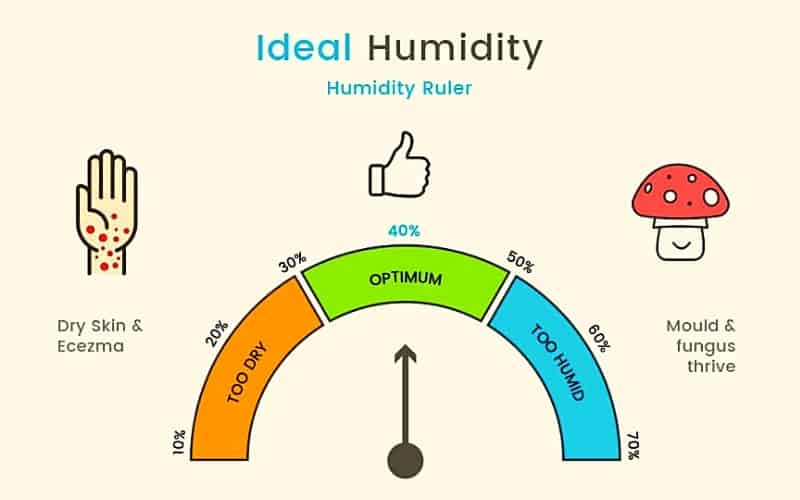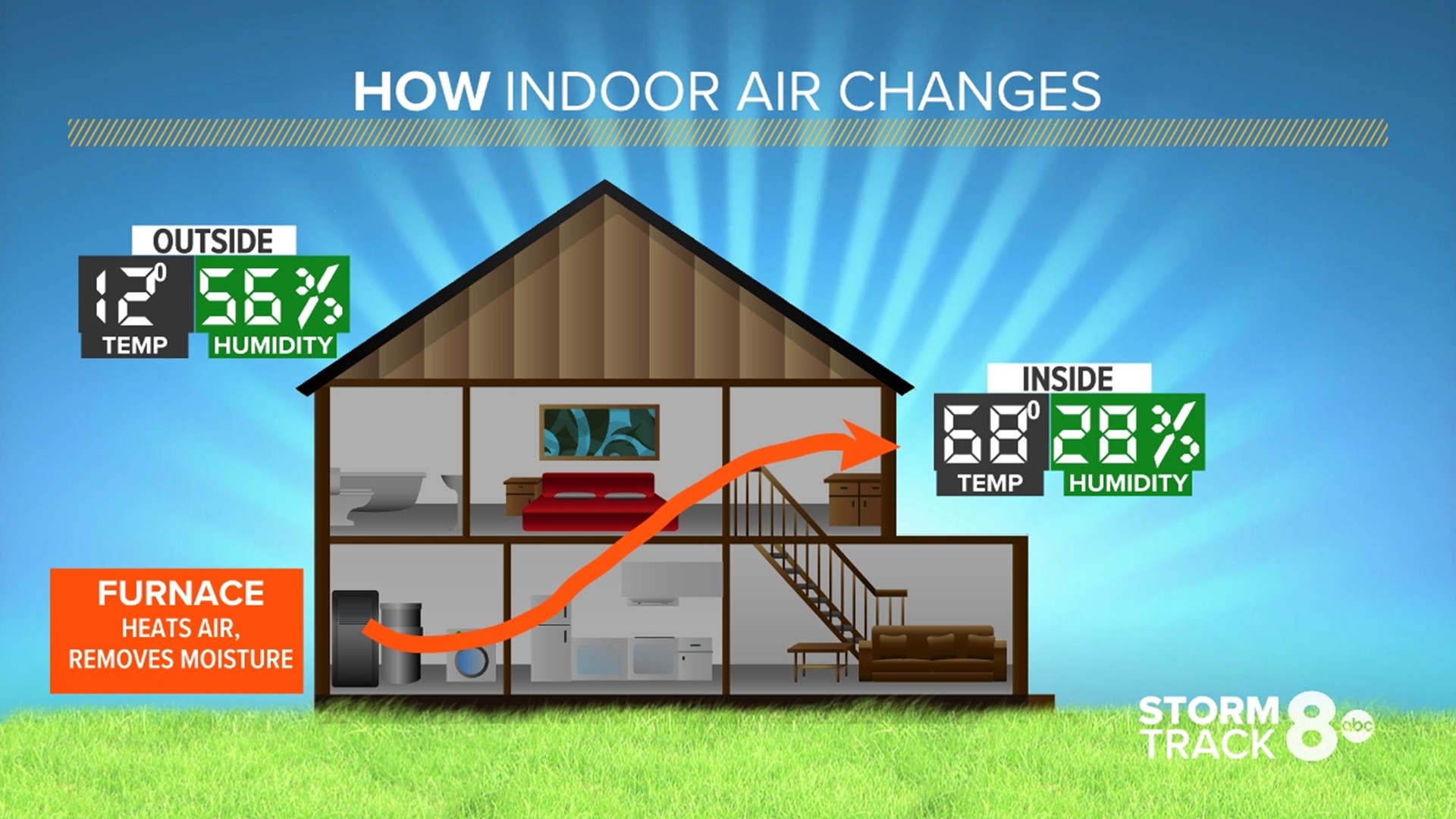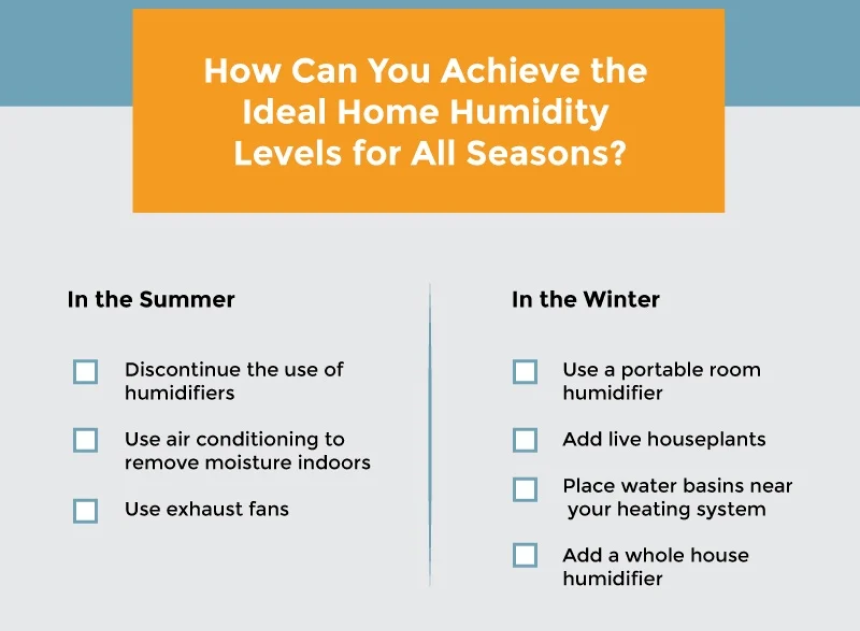How Much Humidity Should Be In The House

Is your home feeling like a swamp in the summer or a desert in the winter? Finding the sweet spot for humidity levels in your house is crucial for comfort, health, and even the longevity of your home's structure. Many homeowners grapple with the frustrating consequences of either excessive humidity (leading to mold, mildew, and that clammy feeling) or insufficient humidity (resulting in dry skin, static electricity, and cracked wood).
The Goldilocks Zone: Aiming for Ideal Humidity
The ideal relative humidity for your home falls between 30% and 50%. This range provides the best balance for preventing both the growth of mold and bacteria, and minimizing issues related to dryness. Keeping your home within this range can significantly improve your overall comfort and well-being.
Step 1: Identifying the Problem – Is Your Home Too Humid or Too Dry?
Before diving into solutions, you need to accurately diagnose the problem. Here’s how:
Signs of High Humidity (Too Much Moisture)
- Visible Mold or Mildew: Check bathrooms, kitchens, basements, and areas around windows. Mold often appears as dark spots or fuzzy growth.
- Condensation: Look for condensation on windows, mirrors, or cold surfaces.
- Musty Odors: A persistent musty smell, especially in damp areas, is a strong indicator of mold or mildew growth.
- Sticking Doors and Windows: Excess moisture can cause wood to swell, making doors and windows difficult to open or close.
- Water Stains: Look for water stains on ceilings, walls, or floors, which could indicate a leak or excessive condensation.
- Feeling Clammy or Sticky: A persistently clammy or sticky feeling inside your home, even when the temperature is comfortable.
Signs of Low Humidity (Too Little Moisture)
- Dry Skin and Itchy Eyes: Low humidity can lead to dry, irritated skin and itchy eyes.
- Static Electricity: Increased static electricity, causing shocks when you touch objects or people.
- Cracked Wood Furniture or Flooring: Dry air can cause wood to shrink and crack.
- Sore Throat and Nasal Congestion: Dry air can irritate your respiratory system, leading to a sore throat, nasal congestion, or nosebleeds.
- Aggravated Allergies or Asthma: Dry air can exacerbate allergy and asthma symptoms.
Step 2: Measuring Humidity Levels with a Hygrometer
Subjective observations are a good starting point, but the most accurate way to determine humidity levels is with a hygrometer. These relatively inexpensive devices measure the amount of moisture in the air. You can find them at most hardware stores or online retailers. Place the hygrometer in a central location in your home, away from direct sunlight or drafts, and allow it to sit for a few hours to get an accurate reading.
Step 3: DIY Fixes for High Humidity
If your hygrometer reading consistently shows humidity levels above 50%, here are some DIY solutions you can try:
Improve Ventilation
- Use Exhaust Fans: Always use exhaust fans in bathrooms and kitchens when showering, bathing, or cooking. Run them for at least 15-30 minutes after to remove excess moisture.
- Open Windows: When weather permits, open windows to ventilate your home and allow fresh air to circulate.
- Ensure Proper Attic Ventilation: Proper attic ventilation is crucial for preventing moisture buildup. Check your attic vents to ensure they are not blocked by insulation or debris.
Address Moisture Sources
- Fix Leaks: Promptly repair any leaks in your roof, plumbing, or around windows and doors. Even small leaks can contribute to significant moisture buildup.
- Cover Cooking Pots: Covering pots while cooking reduces the amount of steam released into the air.
- Vent Your Dryer: Ensure your clothes dryer is properly vented to the outside. A clogged or improperly vented dryer can release large amounts of moisture into your home.
- Control Indoor Plants: While plants can add beauty to your home, they also release moisture into the air. Consider reducing the number of indoor plants or moving them to a well-ventilated area.
Dehumidifiers
- Portable Dehumidifiers: For localized areas with high humidity, such as basements or bathrooms, a portable dehumidifier can be very effective. Choose a dehumidifier with the appropriate capacity for the size of the room.
- Whole-House Dehumidifiers: For persistent humidity problems throughout your home, consider a whole-house dehumidifier. These systems are typically integrated into your HVAC system and can maintain consistent humidity levels throughout the entire house.
Step 4: DIY Fixes for Low Humidity
If your hygrometer reading consistently shows humidity levels below 30%, here are some DIY solutions you can try:
Humidifiers
- Portable Humidifiers: Use portable humidifiers in bedrooms or living areas to add moisture to the air. Clean and maintain humidifiers regularly to prevent the growth of mold and bacteria. Distilled water is generally recommended to avoid mineral buildup.
- Whole-House Humidifiers: Consider a whole-house humidifier for consistent humidity levels throughout your home. These systems are typically installed as part of your HVAC system.
Other Moisture-Adding Techniques
- Boil Water: Simmering a pot of water on the stove can add moisture to the air. Be sure to monitor the pot closely and never leave it unattended.
- Indoor Plants: Indoor plants release moisture into the air through transpiration. Increase the number of indoor plants in your home.
- Hang Laundry Indoors: Air-drying laundry indoors can add moisture to the air, especially during dry winter months.
Step 5: Monitoring and Adjusting
After implementing these fixes, continue to monitor your humidity levels with a hygrometer. It may take some time to achieve the ideal range of 30% to 50%. Adjust your strategies as needed, based on your hygrometer readings and your personal comfort levels.
When to Call a Professional
While many humidity issues can be resolved with DIY solutions, there are certain situations that require professional intervention:
Persistent Mold or Mildew Growth
If you have persistent mold or mildew growth, despite your best efforts to improve ventilation and reduce moisture, it’s essential to consult a mold remediation specialist. Mold can pose serious health risks, and professional remediation is often necessary to safely and effectively remove it.
Significant Water Damage
If you have significant water damage from a leak or flood, it’s crucial to contact a water damage restoration company. These professionals have the expertise and equipment to thoroughly dry and restore your home, preventing further damage and mold growth.
HVAC System Issues
If you suspect that your HVAC system is contributing to humidity problems, it’s best to consult an HVAC technician. They can inspect your system for issues such as leaks, improper ventilation, or malfunctioning components. Attempting to repair your HVAC system yourself can be dangerous and may void your warranty.
Structural Problems
If you suspect that structural problems, such as foundation cracks or inadequate insulation, are contributing to humidity problems, it’s essential to consult a building inspector or contractor. These professionals can assess the structural integrity of your home and recommend appropriate repairs.
Unexplained High Humidity
If you have high humidity and can't pinpoint the source, consider calling a home inspector. They can use specialized tools and expertise to find hidden leaks or moisture sources you might have missed.
Preventative Measures for Long-Term Humidity Control
Beyond addressing immediate humidity problems, taking preventative measures can help maintain optimal humidity levels in your home over the long term:
- Regularly Inspect and Maintain Your Home: Conduct regular inspections of your roof, plumbing, windows, and doors to identify and repair any leaks or damage promptly.
- Improve Insulation: Proper insulation can help regulate temperature and humidity levels in your home. Consider adding insulation to your attic, walls, and crawl spaces.
- Seal Cracks and Gaps: Seal any cracks or gaps around windows, doors, and pipes to prevent air leaks and moisture intrusion.
- Maintain Your HVAC System: Regularly service your HVAC system to ensure it is operating efficiently and effectively. Change air filters regularly and schedule annual maintenance checks.
- Use Vapor Barriers: Install vapor barriers in your walls and crawl spaces to prevent moisture from entering your home.
Understanding the Impact of Climate
Your local climate plays a significant role in the humidity levels inside your home. Those living in humid climates will naturally need to focus more on dehumidification, while those in arid climates will need to prioritize humidification.
Seasonal Adjustments
Humidity levels can fluctuate significantly throughout the year. Be prepared to adjust your humidity control strategies seasonally. During the summer, you may need to rely more on air conditioning and dehumidification, while during the winter, you may need to focus more on humidification.
Conclusion: Take Control of Your Home's Humidity
Maintaining the right humidity level in your home is a key ingredient for a comfortable, healthy, and structurally sound living environment. By understanding the signs of high and low humidity, using a hygrometer to accurately measure levels, and implementing these DIY solutions and preventative measures, you can take control of your home's humidity and enjoy a more pleasant and sustainable living space. Remember to prioritize safety and seek professional help when needed. With a little effort and attention, you can create a home that's perfectly balanced for optimal comfort and well-being.
.jpg?width=3508&name=Humidity level chart (1).jpg)








